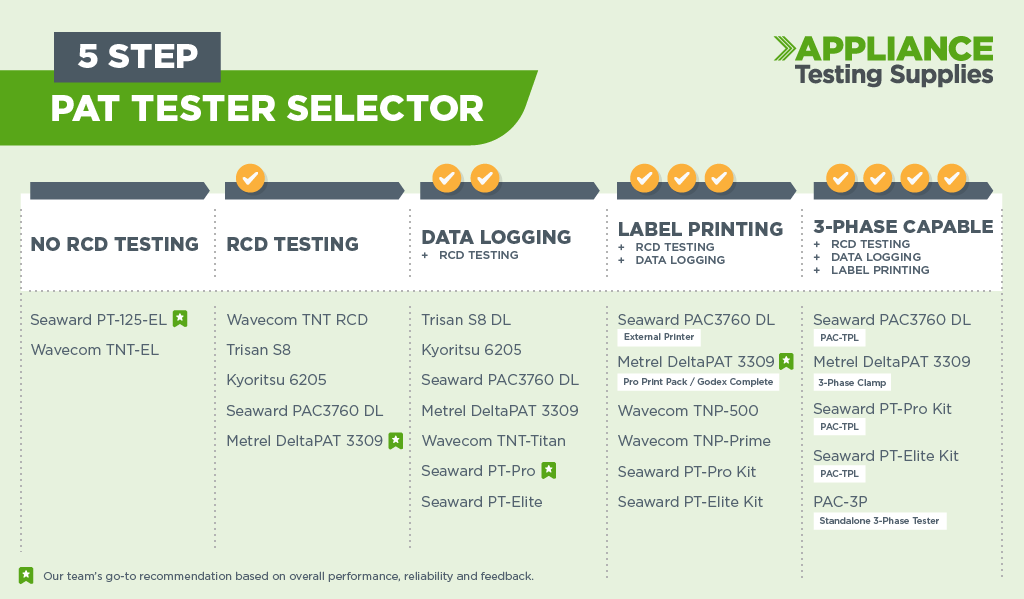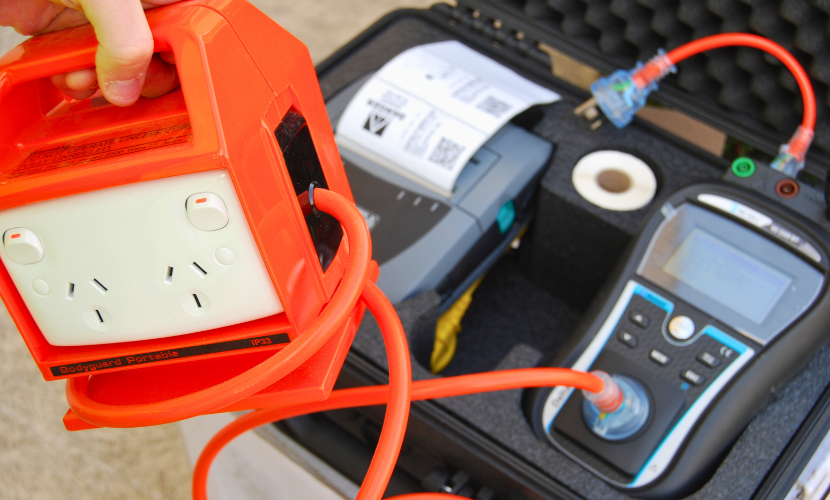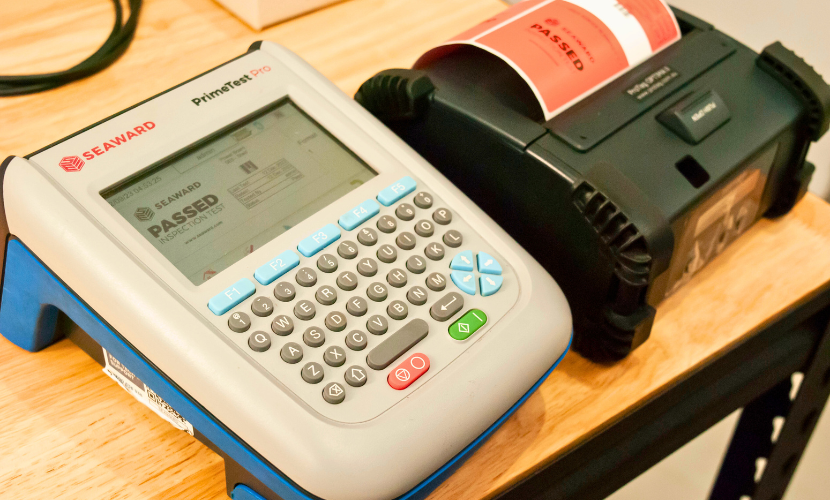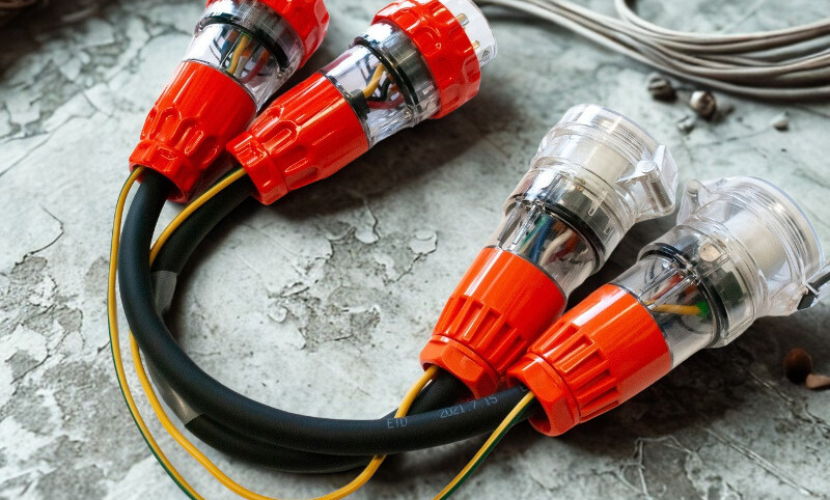The Smart Buyers Guide to PAT Testers in 2025
.png)
What to Know Before Buying a PAT Tester
- Buying a PAT tester can get confusing fast, we get it. There are heaps of models, features, and prices floating around, and it’s not always clear what’s actually useful and what’s just bells and whistles. Whether you're testing and tagging a few tools or running a full-blown test and tag operation, this guide breaks it down clearly - so you can pick the right tester for your needs without second-guessing yourself.
Start Here: Answer These 5 Key Questions
Before diving into PAT Tester brands and budgets, answer these five questions.
Your answer to question 1 helps you figure out where to start in the guide. Once you’ve got that sorted, the graphic below maps out your path through Questions 2 to 5 — so you only focus on the features that actually matter for how you plan to test and tag.
- Are you testing your own equipment, or offering a service to others?
- Do you need to test portable RCDs or 15A appliances?
- Do you want to store test results digitally (not just write them down?)
- Do you want to print tags automatically on-site?
- Are you testing any 3-phase equipment?
Keep these answers handy as you go - they’ll directly impact which tester is right for you.

PAT Testers by Tiers
|
Type
|
Best For
|
Price Range
|
Common Features
|
|---|---|---|---|
| Entry- Level |
In-house, occasional use | Under $1000 | Manual logging, no RCD testing, battery powered |
| Mid- Range |
Regular testing (electricians, tradies) | $1000–$2500 | RCD testing, data storage, optional printer/scanner |
| High-End | Business use, automation, compliance-heavy industries | $2500+ | Full automation, Bluetooth, 3-phase support, wireless syncing |
Your Answers, Matched to the Right Tester
1. Are you Testing your Own Gear, or Offering a Service?
If you're only testing your own tools or office equipment occasionally, you can get away with a simple, affordable test and tag machine. But if you're offering test and tag services to clients, even on a small scale, you’ll likely need RCD testing, reporting, data storage, and tag printing (the next sections will be important to you).
Who it's for:
- Own Gear: tradespeople, sole operators, in-house testing
- Service Provider: test and tag businesses/franchises, electricians, contractors
Just testing your own tools and don't need RCD?
If you answered Own You can skip the more advanced sections. The Wavecom TNT EL and Seaward 125 EL are your best options - both are simple, affordable and fully compliant for basic testing and tagging.
2. Do you Need to Test Portable RCD's?

RCDs (Residual Current Devices) are critical on construction sites, in schools, and in high-risk workplaces. Testing RCDs properly requires an appliance tester with an in-built isolation transformer - either in-built or available as an add-on accessory.
Who it’s for:
Typically found at construction sites, workshops, warehouses, nursing homes, schools or anywhere portable safety switches are used.
Why it matters:
- Without RCD testing, you could fail audits or site requirements, and you’ll likely end up spending more later upgrading or replacing your tester if your needs change.
- Some cheaper appliance testers may claim to do RCD testing but actually require add-ons - or worse, don't comply with AS/NZS 3760.
- If you're working on high-risk sites, RCD functionality is often mandatory - and not having it could lose you contracts or compliance clearance.
| If You Answered YES | If You Answered NO | |
| What You Need | You’ll need a PAT Tester that supports RCD testing. This typically starts from around $800 and up. Most testers in this range can be upgraded to include printing and data logging later. |
You’re likely in a low-risk environment (e.g. small business or just testing your own gear), so you'll just need a basic model like the Wavecom TNT EL or Seaward Primetest 125 EL. |
Basic PAT Testers that support RCD Testing
Wavecom TNT RCD – A no-fuss tester that gets the job done. It includes RCD testing as standard, and is ideal for sole operators or small businesses needing an affordable option. We typically find that the majority of people using the TNT RCD are beginners or new to the industry.
Trisan S8 – This is a feature packed appliance tester that generally offers more than other entry-level ones. It has a very durable and tough design (comes in a pelican case), and offers straightforward RCD testing with built-in flexibility.
Kyoritsu 6205 – Great for industrial environments, this tester is compact but tough, with the ability to test fixed and portable RCDs reliably. It's a little bit more expensive for other comparable models, but does come with extra useful features.
Seaward PAC3760 DL – A very popular tester in schools and commercial settings. Includes RCD functionality and is known for reliability and ease of use.
Metrel DeltaPAT 3309 BT – One the most popular options, the DeltaPAT 3309 BT has a built-in isolation transformer, digital storage, and Bluetooth – so it essentially bridges the gap between entry and professional level testing, making it a strong all-rounder.
Note: Many other PAT Testers support RCD testing, especially in higher-end or upgradeable kits (like the TNP-500 Gen 6 or Delta Pro Print Pack). The models listed above are the minimum level testers with built-in or direct RCD functionality – ideal for users who need it out of the box
3. Do You Want to Store Test Results Digitally?
.jpg)
If you're doing more than a handful of tests per week, storing your test results digitally will save you a massive amount of time. Manual record-keeping becomes tedious, error-prone, and hard to manage as volumes grow.
Who it’s for:
- Test and tag business owners
- Anyone who tests more than 10-20 items a week
- People testing in batches across departments
- School maintenance staff - schools have lots of gear across multiple buildings and helps with retesting
- Anyone working in industries where data logging is mandated i.e. construction sites.
Why it matters:
- Manual record-keeping can quickly become a major bottleneck, especially if you're testing dozens or hundreds of items each month.
- Testers with digital memory make it easy to recall previous results, produce professional reports, and prove compliance - all without flicking through test and tag logbooks.
- If you’re ever needing to demonstrate consistent testing, having organised digital records can be massively helpful.
- Some units allow direct USB or Bluetooth data transfer into software, which means test data can be exported on-site, sent back to the office, or handed to clients almost instantly.
- If you're testing at scale, running out of memory mid-job means stopping, exporting data, and starting again. That’s downtime you don’t need.
In short: this option is fine to skip for basic, low-frequency jobs - but anything more and you'll find yourself wishing you had storage after all.
| If You Answered YES | If You Answered NO | |
| What You Need |
You’ll want a tester with internal memory that can store hundreds or thousands of results. Larger memory is also essential if you're moving across multiple sites or sharing testers among a team – you won’t need to clear memory between jobs, and test history stays intact. |
You’ll need to manually write down test results manually, such as using a test and tag logbook. That might be manageable if you’re only doing a few items every couple of weeks, but it becomes a hassle fast. Manual logging is more prone to errors, and if you lose the paperwork, you lose your proof of compliance. It also makes retesting slower since you can’t recall previous data automatically. |
Basic Testers with Digital Storage
These are your entry-level options that support digital storage but without automation or large memory.
- Trisan S8 DL – This is ideal for users who want simple memory logging without a big learning curve. Can store up to 2000 test results.
- Kyoritsu 6205 – Offers essential data logging functions in a tough, compact frame, which is great for industrial applications. Can store up to 999 test results.
- Seaward PAC3760 DL – This PAT Tester is commonly used in schools and offices for data reporting purposes, storing up to 999 test results. However, the data information stored is not very comprehensive and is not user changeable or editable
Premium Testers with Advanced Storage
These go beyond simple record-keeping and are ideal for anyone doing regular or large-scale testing.
- Metrel DeltaPAT 3309 – Can internally store up to 1500 records. Each entry can include details like asset ID, make, model, location, serial number, and test result. You can then export the data to your PC using the included PATLink PRO software via USB or RS232. This allows for smooth record-keeping and easy and professional looking report generation.
- Wavecom TNT Titan - A larger step up in storage compared to the other Wavecom models and is designed for high-volume users. Can store up to 5000 items (local storage).
- Seaward Primetest Pro – Stores 10,000+ results, with seamless upgrades for printing and scanning. Allows you to record serial numbers, asset ID's and other detailed information directly onto the unit.
- Seaward Primetest Elite+ – 50,000 record capacity, fully programmable, and report-ready. One of the most advanced PAT testers available. Similarly to the PT-Pro, record serial numbers, asset ID's and other information straight into the tester.
4. Do You Want to Print Tags Automatically?

If you’re testing and tagging more than a few items at a time, manually writing electrical test tags gets slow and messy. Automated printing not only saves time but ensures all test tags are neat, consistent, and professional.
Who it’s for:
- Test and tag business owners or franchises
- High-volume industrial testing
- Businesses needing logos, barcodes or consistent branding on test tags
Why it matters:
Some testers include built-in printers, while others connect to Bluetooth or USB tag printers — both make your process quicker and more compliant.
- Handwritten tags can massively slow down your test and tag process, look unprofessional, and are more prone to fading or damage - especially on sites like construction or mining.
- Using a test and tag printer ensures every label looks sharp, includes the right compliance details (like logos, dates, barcodes), and can be scanned later for retesting.
- For anyone doing more than occasional testing, printing saves hours per week, improves professionalism, and helps avoid compliance issues caused by unreadable or inconsistent tags.
| If You Answered YES | If You Answered NO | |
| What You Need | Look for testers that either come with or can connect to a tag printer. Some kits are all-in-one with printers built in (like the TNP-500), while others (like the Primetest Pro) let you choose your own printer. Bluetooth models are great if you want fewer cables on the job site. And if you want to brand your tags with your logo or QR code, make sure the tester and printer combo can handle custom layouts. Also consider durability - thermal transfer tags hold up better in tough environments than basic direct thermal ones. Read our quick guide on Direct Thermal vs Thermal Transfer Tags |
You’ll need to write tags by hand. That can be fine for low-volume users or those testing in a fixed location. |
Testers that Support Tag Printing:
- Seaward PAC3760DL + Printer - This supports an external printer connection for very basic tag printing. This is ideally for lower volume setups that want to avoid handwriting test tags.
- TNP-500 Gen 6 – Built-in thermal transfer printer with up to 4 logo slots. Designed for people doing very high volume of testing and tagging as each tag prints automatically in seconds. The Thermal Transfer Tags are extremely tough and designed for harsh environments, making them ideal for industrial and commercial settings. This effectively means you can use them in any environment.
- TNP Prime- This is another kit from Wavecom, supplied with everything you need in a heavy-duty case. It includes a thermal printer that prints specific data onto the tags and include custom logo's. The main drawback is that it requires a subscription to WinPAT software, which adds an ongoing cost to your setup.
- Delta Pro Print Pack - Fully wireless setup, barcode scanning, and advanced tag customisation. Top-tier setup for test & tag businesses and the main reason it was given the #1 spot in our Top 5 PAT Testers of 2025. Included in the kit is the Zebra ZQ521 Bluetooth printer - a compact, rugged unit that has the flexibility to print both direct thermal and thermal transfer tags with clarity and durability.
- DeltaPAT Godex Complete Kit - An alternative to the Delta Pro Print Pack, this setup features the Godex printer, available in both wired and wireless configurations. The printer supports custom logos, barcodes, and QR codes. The main drawback is its larger size and heavier build, which makes it less portable than other options.
- Seaward Primetest Pro (with accessories) – Add-on printer support, Bluetooth connectivity, and flexible layout control - this is a very solid choice, especially in tough environments like construction and mining. It utilises the ProTag XL Printer which is designed for high-speed tag printing. Important to note: older printers like the Zebra P4T and QL420 are not compatible with the new Primetest Pro
- Seaward XL Elite+ Kit – Similarly to the Primetest Pro, it seamlessly integrates with the ProTag XL Printer and scanner for a premium all-in-one experience.
Want to compare the most popular test and tag printer kits side-by-side?
Check out our full Test & Tag Print Kits Comparison for 2025.
5. Are You Testing 3-Phase Equipment?

3-phase testing is essential if you work in industrial environments or test equipment like welders, commercial kitchen gear, HVAC systems or factory machinery. Not all testers support this out of the box.
Who it’s for:
People working on industrial or commercial sites
Users testing 3-phase machinery, heavy equipment, or 15A gear
Why it matters:
- 3-phase power is used across many industries, and if your tester doesn’t support it, you simply can’t test those appliances.
- Some testers support 3-phase via add-ons, while others are ready to go with optional leads or accessories.
- Even if you're not testing 3-phase now, buying a compatible model could future-proof your setup - avoiding the need to upgrade later.
| If You Answered YES | If You Answered NO | |
| What You Need | Choose a kit with 3-phase capability, either built-in or available via accessories. Look for clear compatibility with 3-phase adapters or leads – not all testers support them. |
Sticking with a model without compatability will suffice – no need to overcomplicate things if you’re only testing single-phase appliances or common workshop gear. |
Testers that Support 3-Phase Testing:
- Seaward PAC3760 DL / PAC-TPL - supports 3-phase with the PAC-TPL accessory - a widely used unit across industries where both single- and 3-phase appliances are present.
- Metrel DeltaPAT 3309 BT / Clamp Meter – The standalone PAT Tester supports 3-phase testing with Metrel’s dedicated Clamp Meter accessory. This means that it will also work with the Delta Pro Print Pack and the Godex Complete Kit.
- Seaward Primetest Pro Kit / PAC-TPL – Works with the PAC-TPL 3-phase accessory. Well-suited for growing businesses with industrial application.
- Seaward XL Elite Kit / PAC-TPL – Integrates with Seaward’s 3-phase PAC-TPL accessory, offering advanced testing across standard and industrial appliances.
- PAC-3P (Standalone Tester) – A dedicated 3-phase tester designed to complement your main single-phase PAT. Ideal for those preferring to keep 3-phase and general testing separate.
Compare PAT Testers Side-By-Side
Not sure which model stacks up best? We’ve created a side-by-side comparison of the most popular PAT Testers - covering key specs like tag printing, data storage, RCD testing, price, and more. It’s the fastest way to find the right model without digging through each product one-by-one.
Common Buying Mistakes to Avoid
Even experienced buyers get tripped up. Here are the most common traps we see — and how to dodge them:
- Buying based on price alone – cheaper doesn’t mean better. You’ll waste more time (and money) if it slows you down.
- Not planning ahead – If you grow your business, upgrade costs later can add up. Choose a model that scales with you.
- Forgetting about compliance – some overseas models use substitute leakage testing - which doesn’t meet AS/NZS 3760.
- Skipping tag printing – handwritten tags fade and look unprofessional. If you’re testing frequently, get printing sorted.
- No data storage – logging test results by hand is fine, until you’re testing 40+ items a day. Go digital if you're serious.
- Ignoring the testing environment – If you’re testing on-site, go battery powered. If it’s industrial, make sure it handles 3-phase.
- Overlooking support & warranty – cheaper PAT Testers may not come with local support or decent warranty. We offer lifetime tech support with every tester we sell, and it's completely free.
Still not sure which PAT Tester is Right for You?
- Call us on 1300 656 938
- Contact our team for expert advice
- Use our comparison charts
- For a quick shortlist, see our Top 5 PAT Testers of 2025
